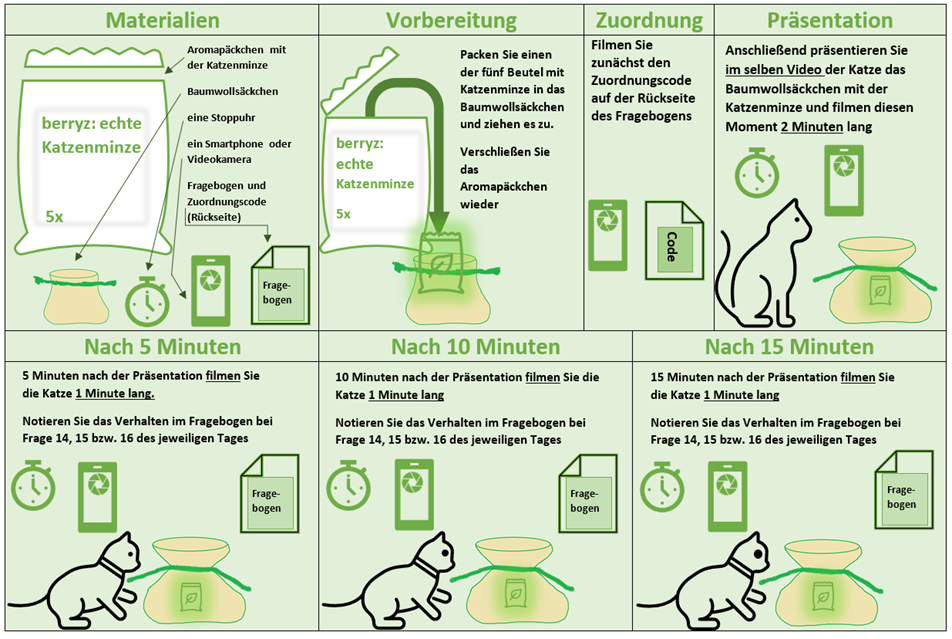
6020 Innsbruck
Cats do science
1. Description
Take part in a Citizen Science Project, in which your cat will play the main role! According to current knowledge, any kind of damage or addiction to catnip can be ruled out – the administration of catnip to the cat is completely harmless. The experiment requires about 20 minutes a day for three days in a row (preparation time is included). At the end of the experiment, a total of 15 minutes of recordings should result.
2. General
Dear Citizen Scientists!
First of all, thanks to all of you who decided to participate in a Citizen Science Project. The favourite domestic animal of Austrians and Germans are cats. They can be encountered in about 16% of Austrian household, which makes up every 6th household with a feline. You must’ve already heard about how cats go crazy about catnip (Nepeta cataria) that has been named after them. Reports on their reactions to the herb vary a lot: some show little or no interest at all, whereas others enjoy every touch or even fall into a state of euphoria. Researchers all over the world are eager to know why cats in particular cannot resist the scent of catnip, and initial finding are emerging.
Important: There are no reports or indications about catnip being harmful to your cat.
Furthermore, there are still many unanswered questions. The questions that I’ve been asking myself are whether cats can develop a resistance to catnip and whether distinguishing features such as gender, genetics or age have any influence on the development of resistance. At a regular consumption of various intoxicants and stimulants, humans must take a higher dose of a substance to achieve the same effect, or in other words: the effect diminishes if the amount of a substance remains the same. Together with my master thesis and you participating, I want to examine this hypothesis and create findings. For this, please read through the following points.

3. Preparation and instructions
- The experiment requires 20 minutes each of three consecutive days. The time for the experiment for the participant is free to be chosen, however, the continuation on the following days should be carried out roughly at the same time as on the first day (± 1 hour).
- The contents of the test kit
- information sheet
- questionnaire with an assignment code of six digits on the backside
- five sacks of catnip (about 9g each) (be careful when taking out the sacks – they are not sealed)
- a cotton bag
- One test kit is to be used for one cat. During the administration of catnip to the cat, the feline mustn’t have any contact to other cats.
Note that only three out of five sacks with catnip are needed. The other two are meant as a small token of attention to you and for personal use. Should your cat show no interest in the catnip, you could use the herb for tee as well.
4. Allocation of tasks
The tasks of the citizen scientist consist of preparing and recording the experiment, and filling out the questionnaire. For the preparation: according to instructions, stuff one sack of catnip into the cotton bag and lace it up. Administer the bag to the cat by either placing the bag in front of the feline or bringing the feline directly to the bag. Now, start recording by showing the administration code first, then the cat according to chapter 5 “Performing the experiment”.
Upload the videos to the upload link (to be found in the second e-mail) and fill out the questionnaire online. Every video and completed questionnaire will then be analysed to see whether changes of behaviour throughout the experiment appear and whether estimations on the cats’ behaviour can be made based on distinguishing features such as gender, genetics, age, etc. Besides, the hypothesis that none or barely interested cats can learn to react to catnip by the administration is to be examined as well.
5. Performing the experiment
In order to carry out the experiment, a smart device (e.g., smartphones, tablets, etc.) or a video camera are required for recording. Then, a total of 16 minutes is needed for the performing.
Step 1: Stuff one of the sacks with catnip into the cotton bag.
Step 2: Start recording. Briefly and discernibly, show the administration code on the backside of the questionnaire. Start a stopwatch or note the time when administrating the cotton bag to the cat (t0) and record the cat’s reaction for two minutes. Interact with the feline as little as possible after starting the experiment.
Step 3: Five minutes after the administration (t5), record the cat’s reaction for one minute.
Step 4: Ten minutes after the administration (t10), record the cat’s reaction for one minute.
Step 5: 15 minutes after the administration (t15), record the cat’s reaction for one minute.
- Find an instruction video on the homepage of the faculty of zoology (link located further below).
- The last page of this project description shows a pictorial instruction.
- A total of five minutes video material should result per day – 15 minutes for the entire experiment over three days.
- Should the cat lose interest, please note the precise time (tx) at which the cat shows no more response.
- Should the cat show no interest in the catnip at all, note that as well, as that counts as a result too. If no interest is shown, no recordings are needed.
- Change or clean the location after the first and second day of administration. That ensures best condition, without influences of the day before.
- During the 16 minutes of administration, do not give the cat any kind of treats or titbits, otherwise, feed the cat as usually.
- Find the administration code that is assigned to one cat only on the backside of the questionnaire.
- The first video of each day should include a brief recording of the code right at the beginning; the recording of the code should not be a separate video.
- The chronological order of the videos should evidently be named automatically by your smart device. Naturally, you can rename the videos as long as the date and time are made clear.
- In a second e-mail, find a link for the video uploads and a link for the digital questionnaire.
- The digital questionnaire corresponds to the questionnaire in the test kit that serves only for personal notetaking for the duration of the experiment. Should any problem arise when filling out the online questionnaire, please send us the completed questionnaire per e-mail.
- For further questions regarding the upload, experiment or any problems, feel free to contact me at This email address is being protected from spambots. You need JavaScript enabled to view it..
- The uploaded videos cannot be watched by other participants due to data protection!
6. Purpose of the experiment
The purpose of the experiment is to observe and examine how cats’ behaviour might change or diminish if they are exposed to catnip for three consecutive days. The more participants we have, the more significant are the results.
7. Contents of the test kit
The catnip used for this Citizen Science Project comes from barryz.de, based in Germany. To this grown in France catnip we attach great value – meaning, it is grown naturally and it contains no artificial colouring, preservatives and is completely GM-free (not genetically engineered). Besides, the catnip is fully vegan and gluten free. The five sacks with the catnip of the brand Cilia are made of pure paper fibres, the cotton bag of the brand SAKETOS consists of 100% cotton. The test kit does not contain anything that could harm you or your cat.
8. Related links
For more information on this project, please visit the project homepage of the faculty of zoology at the university of Innsbruck.
Otherwise, feel free to watch our YouTube video.
If you have any further questions, please do not hesitate to contact us: This email address is being protected from spambots. You need JavaScript enabled to view it.
I wish you and your cat a lot of fun with the experiments!

Picture Gallery
-
 Relaxation Relaxation
Relaxation Relaxation -
 Contact Contact
Contact Contact -
 Packing Packing
Packing Packing -
 Smell Smell
Smell Smell -
 Working process aroma bags Working process aroma bags
Working process aroma bags Working process aroma bags -
 Working process teabags Working process teabags
Working process teabags Working process teabags -
 aroma bags aroma bags
aroma bags aroma bags -
 Catnip Catnip
Catnip Catnip
https://citizen-science.at./en/projects/project-archive/cats-do-science#sigProId6b6bde7bd2
This project fulfilled version 1.1 of the quality criteria for citizen science projects on Österreich forscht.


